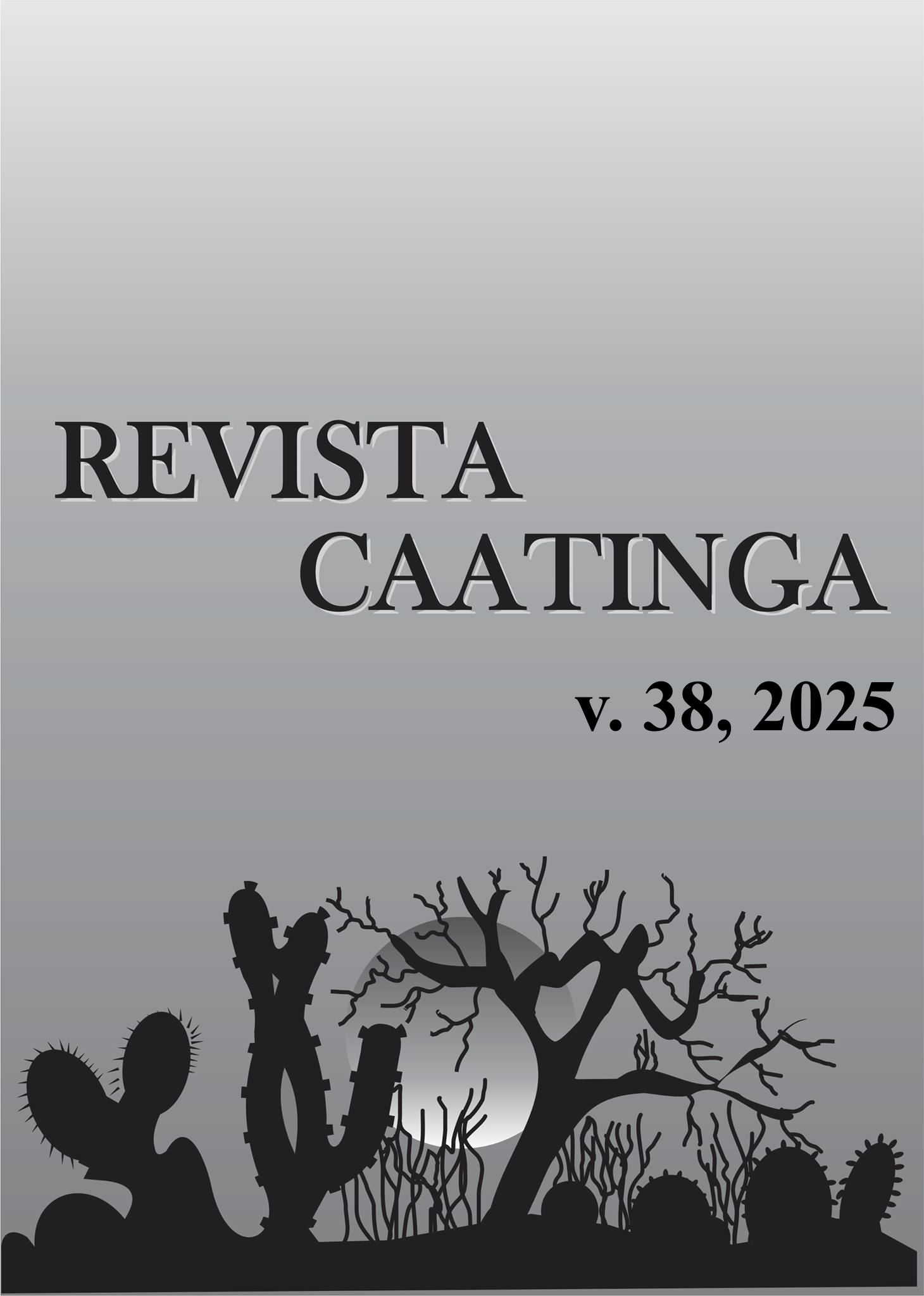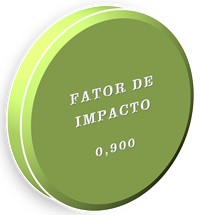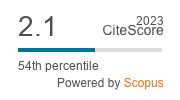Genetic diversity among acerola accessions collected in different brazilian states using ISSR markers
DOI:
https://doi.org/10.1590/1983-21252025v3812697rcKeywords:
Malpighia emarginata. Genetic breeding. Molecular markers. Genetic divergence.Abstract
Commercial acerola (Malpighia emarginata Sessé & Moc. ex DC.) orchards in Brazil are typically established using only one or two genotypes, making them highly susceptible to biotic and abiotic stresses. Molecular characterization of available germplasm can help identify valuable alleles for the development of new cultivars. This study aimed to assess the genetic diversity of a representative sample of acerola germplasm cultivated in Brazil using inter-simple sequence repeat (ISSR) primers. Genomic DNA was extracted from 96 accessions conserved in Petrolina, Pernambuco state (PE) and amplified using 15 ISSR primers. The presence/absence of bands was scored to estimate allelic similarity based on the Jaccard index, and a dendrogram was constructed using the UPGMA method. Genetic variation within and between groups was quantified via analysis of molecular variance (AMOVA), using Genes, GenAlex and Cervus software. The accessions were grouped into 24 clusters, with ACO01 and MAR12 being the most divergent and Costa Rica and Flor Branca the most similar. The cluster analysis revealed substantial variation among individuals from the same region (81%), a result confirmed by AMOVA and the Shannon-Wiener diversity index. The ISSR primers effectively captured the genetic variation among the accessions studied. Given that the samples analyzed represent acerola germplasm cultivated across Brazil, these results provide valuable insights for the management of genetic resources and the development of acerola breeding programs.
Downloads
References
ABD-DADA, H. et al. Use of ISSR markers to assess the genetic diversity of an endemic plant of Morocco (Euphorbia resinifera O. Berg). Journal of Genetic Engineering and Biotechnology, 21: 1-12, 2023.
BARROS, B. R. S. et al. Phytochemical analysis, nutritional profile and immune stimulatory activity of aqueous extract from Malpighia emarginata DC leaves. Biocatalysis and Agricultural Biotechnology, 23: 1-29, 2020.
BOLSTEIN D, et al. Construction of genetic linkage map in man using restriction fragment length polymorphism. American Journal of Human Genetics, 32: 314-331, 1980.
CAIXETA, E. T. et al. Tipos de marcadores moleculares. In: BORÉM, A.; CAIXETA, E. T. (Eds.) Marcadores moleculares. Viçosa, MG: Universidade Federal de Lavras, 2016. v. 2, cap. 1, p 11-94.
CRUZ, C. D. Genes Software – extended and integrated with the R, Matlab and Selegen. Acta Scientiarum, 38: 547-552, 2016.
DOYLE, I. J.; DOYLE, J. L. Isolation of plant from fresh tissue. Focus, 12: 13-15, 1990.
FELIX, F. C. et al. APPLICATIONS OF ISSR MARKERS IN STUDIES OF GENETIC DIVERSITY OF Pityrocarpa moniliformis. Revista Caatinga, 33: 1017-1024, 2020.
HEJAZI, S. M. H. Evaluation of genetic diversity in different populations of six salvia species using R-ISSR markers analysis. Genetic Resources and Crop Evolution, 71: 1-15, 2023.
HOBAN, S. et al. Genetic diversity is considered important but interpreted narrowly in country reports to the Convention on Biological Diversity: Current actions and indicators are insufficient. Biological Conservation, 261: 109-233, 2021.
IBGE - Instituto Brasileiro de Geografia e Estatística. Censo Agropecuário 2018. Available at: <https://sidra.ibge.gov.br/tabela/6616#resultado>. Access on: May 5, 2024.
JACCARD, P. Étude comparative de la distribution florale dans une portion des Alpes et des Jura. Bulletin de lá Société vaudoise dês sciences naturelles. 37: 547-579, 1901.
KALINOWSKI, S. T.; TAPER, M. L.; MARSHALL, T. C. Revising how the computer program CERVUS accommodates genotyping error increases success in paternity assignment. Molecular Ecology, 16: 1099-1106, 2007.
KAMALI, M. et al. Association analysis and evaluation of genetic diversity of Teucrium stocksianum Boiss. populations using ISSR markers. Genetic Resources and Crop Evolution, 70: 691-709, 2023.
LIMA, E. N. et al. Diversidade genética de clones de aceroleira avaliada por meio de marcadores moleculares ISSR. Comunicata Scientiae, 6: 174-180, 2015.
MALEGORI, C. et al. Comparing the analytical performances of Micro-NIR and FT-NIR spectrometers in the evaluation of acerola fruit quality, using PLS and SVM regression algorithms. Talanta, 165: 112-116, 2017.
MARÇAL, K. L. G. Estudo da fração repetitiva do genoma e análise citogenética comparativa em acessos de aceroleira (Malpighia emarginata Sessé & Mociño, ex-D.C.). 2024. 61 f. Dissertação (Mestrado em produção vegetal: Área de Concentração em Recursos Genéticos, Melhoramento Vegetal e Biotecnologia) – Universidade Federal do Vale do São Francisco, Petrolina, 2024.
MEDRAOUI, L. et al. Genetic diversity analysis of sorghum (Sorghum bicolor L. Moench) landraces from northwestern Morocco using ISSR and AFLP markers. Genetic Resources and Crop Evolution, 71: 1-16, 2023.
MISKINIS, R. A. S.; NASCIMENTO, L. Á.; COLUSSI, R. Bioactive compounds from acerola pomace: A review. Food Chemistry, 404: 134-613, 2023.
NEI, M. Molecular evolutionary genetics. 1. ed. Chichester, NY: Columbia University Press, 1987. 514 p.
OLĘDZKI, R.; HARASYM, J. Acerola (Malpighia emarginata) Anti-Inflammatory Activity-A Review. International Journal of Molecular Sciences, 25: 1-17, 2024.
SANTOS, T. S. R.; LIMA, R. A. Cultivo de Malpighia emarginata L. no Brasil: uma revisão integrativa. Journal of Biotechnology and Biodiversity, 8: 333-338, 2020.
SMOUSE, P. E.; PEAKALL, R.; GONZALES, E. A heterogeneity test for fine-scale genetic structure. Molecular Ecology, 17: 3389-3400, 2008.
SOUZA, F. F. et al. Contribuição das pesquisas realizadas na Embrapa Semiárido para a cultura da aceroleira. Petrolina, PE: EMBRAPA, 2017. 28 p. (Documento, 282).
SOUZA, F. F. Principais variedades de aceroleiras cultivadas no Submédio do Vale do São Francisco. Petrolina, PE: EMBRAPA, 2013. 23 p. (Documento, 255).
VILVERT, J. C. et al. Genetic Diversity on Acerola Quality: A Systematic Review. Brazilian Archives of Biology and Technology, 67: 1-12, 2024.
Downloads
Published
Issue
Section
License
Os Autores que publicam na Revista Caatinga concordam com os seguintes termos:
a) Os Autores mantêm os direitos autorais e concedem à revista o direito de primeira publicação, com o trabalho simultaneamente licenciado sob a Licença Creative Commons do tipo atribuição CC-BY, para todo o conteúdo do periódico, exceto onde estiver identificado, que permite o compartilhamento do trabalho com reconhecimento da autoria e publicação inicial nesta revista, sem fins comerciais.
b) Os Autores têm autorização para distribuição não-exclusiva da versão do trabalho publicada nesta revista (ex.: publicar em repositório institucional ou como capítulo de livro), com reconhecimento de autoria e publicação inicial nesta revista.
c) Os Autores têm permissão e são estimulados a publicar e distribuir seu trabalho online (ex.: em repositórios institucionais ou na sua página pessoal) a qualquer ponto antes ou durante o processo editorial, já que isso pode gerar alterações produtivas, bem como aumentar o impacto e a citação do trabalho publicado (Veja O Efeito do Acesso Livre).







